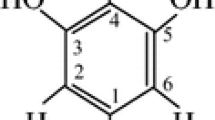Abstract
Three different RYDMR (reaction-yield detected magnetic resonance) techniques, photoconductivity detected magnetic resonance (PCDMR), transient-absorption detected magnetic resonance (ADMR) and delayed fluorescence detected magnetic resonance (DFDMR), are applied to the investigation of the radical-ion pair formed in the photolysis of TMPD in mixed alcohol solution. Here, PCDMR is a newly developed RYDMR method to study the radical-ion pair. PCDMR and ADMR methods show the acceleration of the quenching reaction from the triplet manifold of the radical-ion pair by microwave radiation under electron spin resonance conditions. These spectra of the radical-ion pair are significantly broadened probably because of the dynamic behavior of the radical-ion pair interacting strongly. The long lifetime of the radical-ion pair is due to the Coulomb interaction and the special role of the mixed solvent containing 2-propanol that stabilizes the radical-ion pair. Furthermore, the simultaneous observation of the PCDMR and the DFDMR shows different spectra. This indicates that the spectrum observed by the DFDMR is due to the weakly interacting RIP formed through the pathway different from those observed by the other two methods.
Similar content being viewed by others
References
Hirata Y., Mataga N.: J. Phys. Chem.89, 4031–4035 (1985)
Tanimoto Y., Watanabe T., Nakagaki R., Hiramatsu M., Nagakura S.: Chem. Phys. Lett.116, 341–344 (1985)
Percy L.T., Baker M.G., Trifunac A.D.: J. Phys. Chem.93, 4393–4396 (1989)
Bakker M.G., Trifunac A.D.: J. Phys. Chem.95, 550–555 (1991)
Murai H., Kuwata K.: Chem. Phys. Lett.164, 567–570 (1989)
Shkrob I.A., Cromack K.R., Trifunac A.D.: Chem. Phys.202, 117–128 (1996)
Avdievich N., Jeevanjan A.S., Forbes M.D.E.: J. Phys. Chem.100, 5334–5342 (1996)
Wasielewski M.R., Bock C.H., Bowman M.K., Norris J.R.: Nature303, 520–522 (1983)
Batchelor S.N., McLauchlan K.A., Shkrob I.A.: Mol. Phys.75, 501–529 (1992)
Maeda K., Araki Y., Kamata Y., Enjo K., Murai H., Azumi T.: Chem. Phys. Lett.262, 110–114 (1996)
Murai H., Matsuyama A., Ishida T., Iwasaki Y., Maeda K., Azumi T.: Chem. Phys. Lett. (in press)
Shiraishi H., Ishigure K., Morokuma K.: J. Chem. Phys.88, 4637–4649 (1988)
Shushin A.I.: Chem. Phys. Lett.181, 274–278 (1991)
Author information
Authors and Affiliations
Rights and permissions
About this article
Cite this article
Murai, H., Matsuyama, A., Iwasaki, Y. et al. Several RYDMR studies on the radical-ion pair formed in the photolysis of TMPD: Photoconductivity, transient-absorption and fluorescence detection methods. Appl. Magn. Reson. 12, 411–422 (1997). https://doi.org/10.1007/BF03164122
Received:
Issue Date:
DOI: https://doi.org/10.1007/BF03164122




